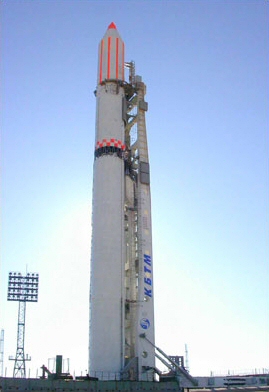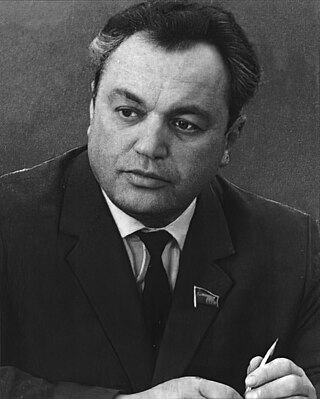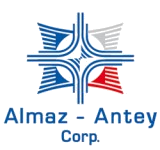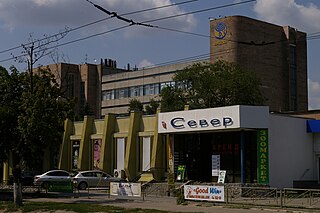
The R-13 was a submarine-launched ballistic missile (SLBM) developed by the Soviet Union starting around 1955. It was assigned the NATO reporting name SS-N-4 Sark and carried the GRAU index 4K50.

JSC Kalashnikov Concern, known until 2013 as the Izhevsk Machine-Building Plant, is a Russian defense manufacturing concern and joint-stock company headquartered in the city of Izhevsk in the Republic of Udmurtia as well as the capital city of Moscow. The concern designs and produces a wide range of civilian and military weapons including assault rifles, sniper rifles, designated marksman rifles, machine guns, squad automatic weapons, hunting rifles, shotguns, guided artillery projectiles, and a wide range of other precision weapons including remote controlled weapon stations, unmanned vehicles and military robots.

The R-2 was a Soviet short-range ballistic missile developed from and having twice the range as the R-1 missile. Developed from 1946-1951, the R-2 entered service in numbers in 1953 and was deployed in mobile units throughout the Soviet Union until 1962. A sounding rocket derivative, the R-2A, tested a prototype of the dog-carrying capsule flown on Sputnik 2 in 1957. The same year, the R-2 was licensed for production in The People's Republic of China, where it entered service as the Dongfeng 1.

The State Factory "Production Union Pivdennyi Machine-Building Plant named after O.M. Makarov", officially abbreviated as Pivdenmash and previously as Yuzhmash, meaning Southern Engineering is a Ukrainian state-owned aerospace manufacturer. It was formerly a Soviet state-owned factory prior to 1991.

The R-27 Zyb was a submarine-launched ballistic missile developed by the Soviet Union and employed by the Soviet Navy from 1968 through 1988. NATO assigned the missile the reporting name SS-N-6 Serb. In the USSR, it was given the GRAU index 4K10. It was a liquid fuel rocket using a hypergolic combination of unsymmetrical dimethylhydrazine (UDMH) as fuel, and nitrogen tetroxide (NTO) as oxidizer. Between 1974 and 1990, 161 missile launches were conducted, with an average success rate of 93%. Total production was 1800 missiles.

The R-12 Dvina was a theatre ballistic missile developed and deployed by the Soviet Union during the Cold War. Its GRAU designation was 8K63, and it was given the NATO reporting name of SS-4 Sandal. The R-12 rocket provided the Soviet Union with the capability to attack targets at medium ranges with a megaton-class thermonuclear warhead and constituted the bulk of the Soviet offensive missile threat to Western Europe. Deployments of the R-12 missile in Cuba caused the Cuban Missile Crisis in 1962. A total of 2335 missiles were produced; all were destroyed in 1993 under the START II treaty.

The JSC Makeyev Design Bureau is a Russian missile design company located in Miass, Russia.

Viktor Petrovich Makeyev was a Soviet engineer in the Soviet space program who was also a central and founding figure in development of Submarine-launched ballistic missile (SLBM) for the Soviet Navy.

The RSM-56 Bulava is a submarine-launched ballistic missile (SLBM) developed for the Russian Navy and deployed in 2019 on the new Borei class of ballistic missile nuclear submarines. It is intended to serve as a crucial component of Russia's nuclear triad. The weapon takes its name from bulava, a Russian word for mace. Unlike other SLBMs, the Bulava is equipped with a wide range of modern penetration aids designed to neutralise and blind enemy ABM systems and radars, and the missile’s active trajectory leg is significantly shorter than that of its competitors, making it much harder to intercept.

The Khrunichev State Research and Production Space Center is a Moscow-based manufacturer of spacecraft and space-launch systems, including the Proton and Rokot rockets, and the Russian modules of Mir and the International Space Station.
JSC Votkinsk Machine Building Plant is a machine and ballistic missile production enterprise based in Votkinsk, Republic of Udmurtia, Russia. Its production includes the RS-24 Yars intercontinental ballistic missile, Russia's most recent ICBM development, as well as the submarine-launched Bulava SLBM.
Obukhov State Plant is a major Russian metallurgy and heavy machine-building plant in St. Petersburg, Russia.

NPO Novator is a Russian company that designs long-range anti-aircraft missiles. It was established in 1947 as OKB-8 in Sverdlovsk, became independent in 1991, and then became part of the Almaz-Antey conglomerate. It is perhaps best known for designing the 9M82 and 9M83 missiles of the S-300V SAM system.
The arms industry of Russia is a strategically important sector and a large employer in the Russian Federation. As of 2024, it employs approximately 3.5 million people nationwide and accounts for 20% of all manufacturing jobs in Russia.

JSC Concern VKO "Almaz-Antey" is a Russian state-owned company in the arms industry, a result of a merger of Antey Corporation and NPO Almaz, unifying some of the national military enterprises, in particular, the developers of anti-aircraft defence and cruise missile systems. The organisation is headquartered in Moscow and is the world's eighth-largest defence contractor measured by 2017 defence revenues. In 2017, Almaz-Antey had arms sales of $9.125 billion.
Open joint-stock company (JSC) NMZ or Nizhny Novgorod Machine-building Plant is a Russian artillery factory in the Sormovo district of Gorky. It included the TsAKB artillery design bureau led by Vasiliy Grabin.

The R-11 Zemlya, GRAU index 8A61 was a Soviet tactical ballistic missile. It is also known by its NATO reporting name SS-1b Scud-A. It was the first of several similar Soviet missiles to be given the reporting name Scud. Variant R-11M was accepted into service, with GRAU index 9K51 (9К51).

Aleksandr Davidovich Nadiradze was a Soviet engineer of Georgian ethnicity who was instrumental in militarization of the former Soviet space program.

JSC "Khartron" (Hartron) is one of the leading design engineering bureaus in former Soviet states, which develops and produces spacecraft and missile control systems.

Atommash («Атоммаш») is a multidisciplinary engineering company located in Volgodonsk, Rostov Oblast, Russia. It was established in 1976 as a nuclear engineering corporation. Following privatization and bankruptcy in 1999, the industrial facilities of the enterprise were owned and managed by ZAO Energomash–Atommash, a part of the diversified engineering company Energomash.
















